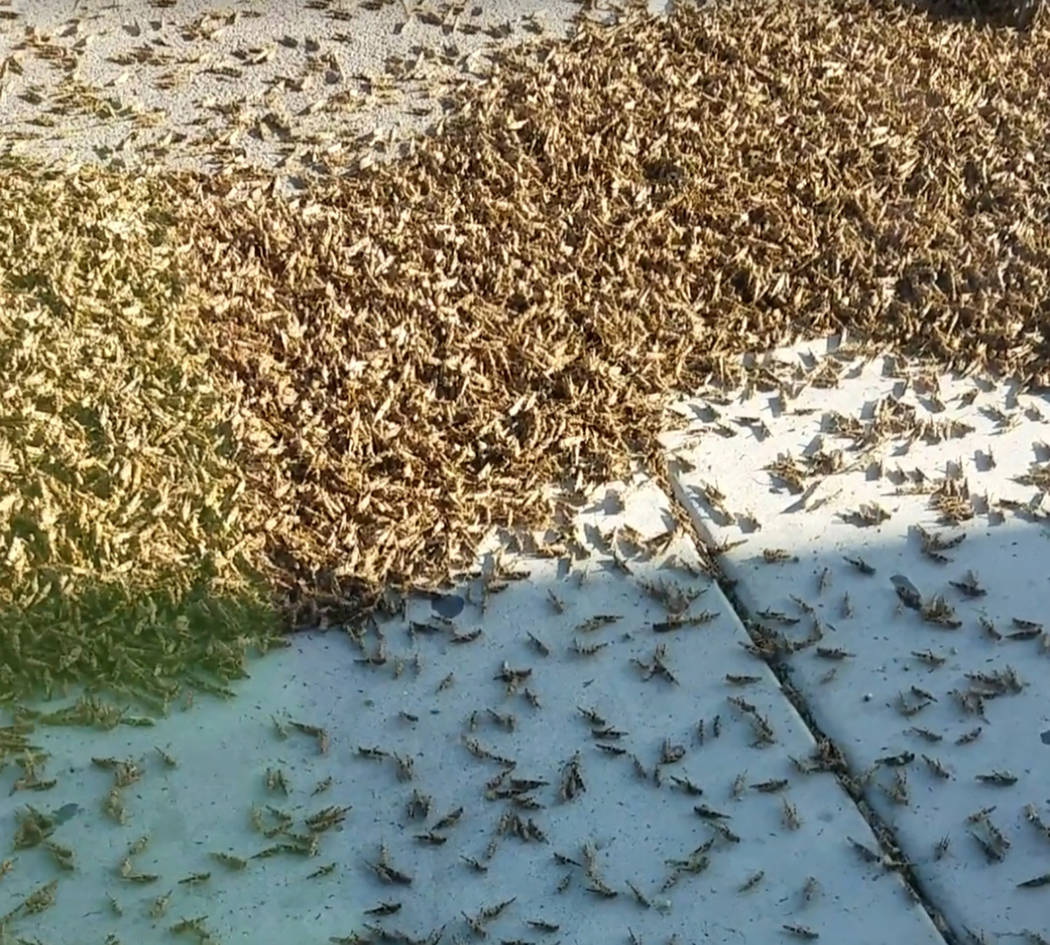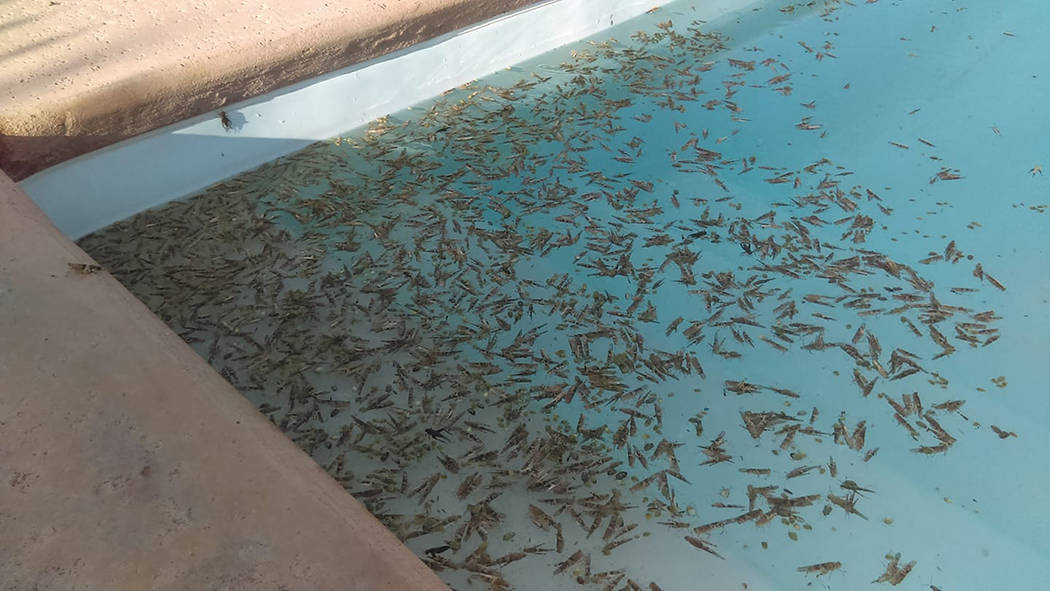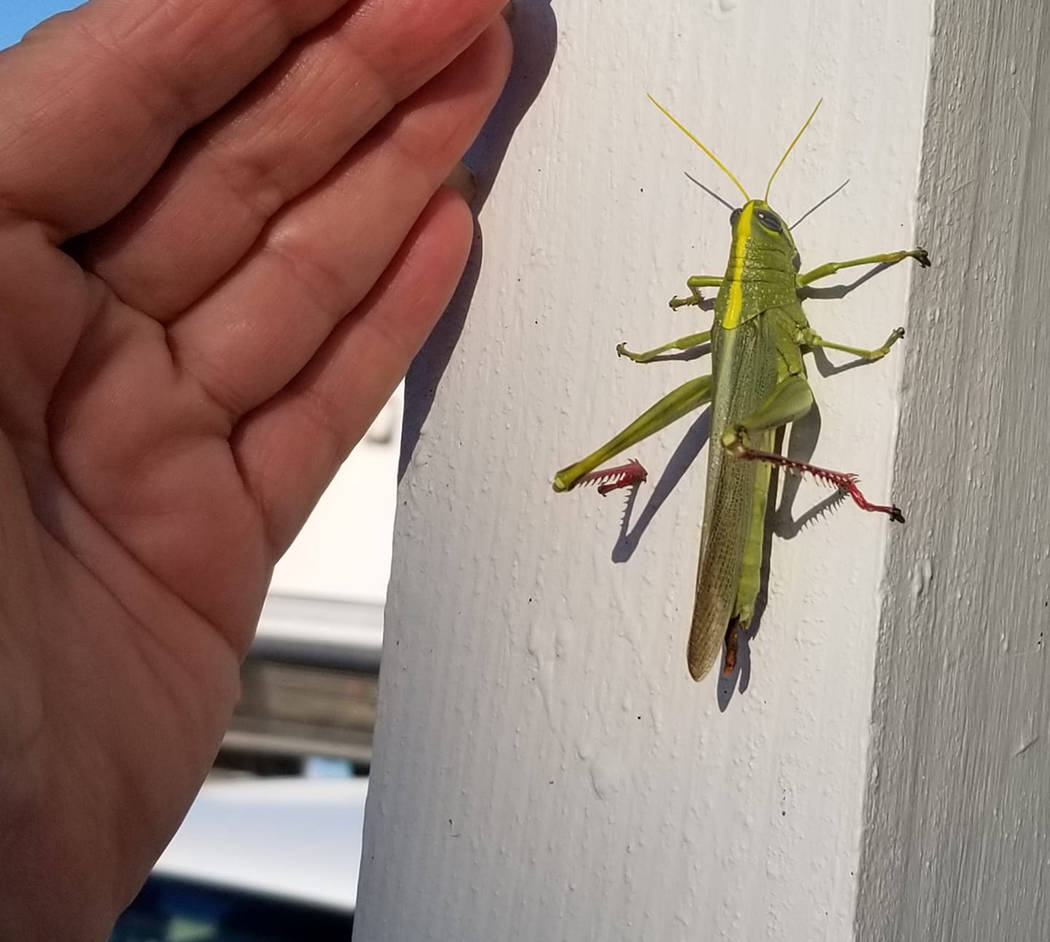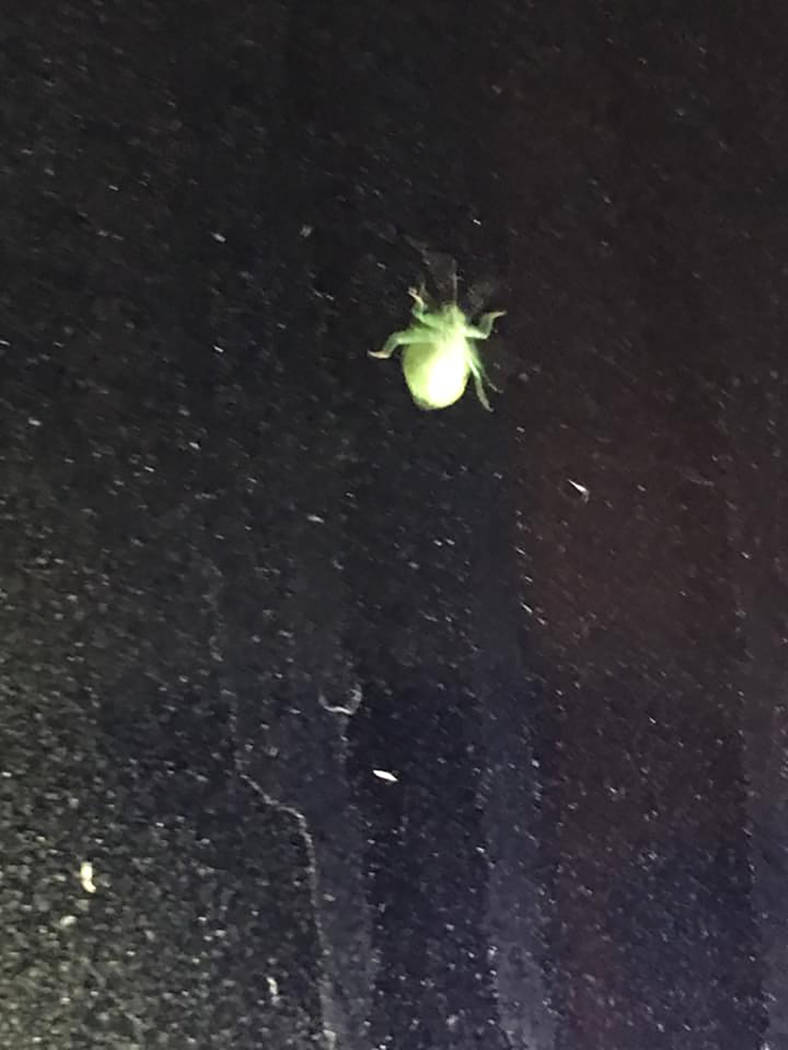Flying insects descend upon Pahrump region
It seems that Mother Nature has played a big role in the recent Southern Nevada grasshopper invasion.
As noted by Nevada Department of Agriculture Entomologist Jeff Knight, the Pallid-Winged Grasshopper is a very common desert species, which appears prominently over the years when the Silver State experiences unusually wet winters or springs.
They should not be confused with locusts, as all locusts are considered to be grasshoppers, but not all grasshoppers are locusts, he said.
The grasshoppers have also been accompanied by hoards of green stink bugs, due to the recent wet conditions.
Knight, during a news conference on Thursday, July 25, said the winged insects normally build up below Laughlin, Nevada and into Arizona by the tens of thousands, where they then migrate this time of year and move northward.
A long flight
Laughlin is roughly 165 miles south of Pahrump.
“They will often move as far north as Central Nevada,” he said. “This is a big year, and it just happened within the past couple of days, in Las Vegas. From all of our information and data from past years, it was most likely caused by the very wet winter and spring that we had. A lot of times, once the populations get big, there are things that trigger the insects to move and find new areas. In other words, once they get so many of them, they start looking for a new place, and for whatever reason the migration is northward.”
Not dangerous
Knight also said judging from records dating back to the 1960s, the mass migration occurs on a fairly regular basis.
He also said the insects are an innocuous species and are more of a nuisance, rather than a danger to humans.
“I’ve seen these kinds of numbers, or even a little bit bigger numbers, four or five times in my 30-plus years,” he said. “They don’t carry any diseases, and they don’t bite or sting. Basically, they are just moving through, where they come and settle in, then at night, they take off and fly fair distances, up to several hundred miles at night. I would guess that it would be a couple of weeks at the most, before they clear out. They are not even one of the species that we consider a problem.”
Night flights
Knight also noted that once in flight, the creatures become attracted to certain types of lighting.
“It’s the ultraviolet lights that they are attracted to, so if you go with a low UV or amber light, you won’t have grasshoppers,” he said. “As far as how fast they migrate, it depends on the weather, so it would be hard to say. The grasshoppers that are here will leave, but a bunch of them will come back in over this period of time.”
As herbivores, Knight said though the grasshoppers can pose a threat to crops, they do not pose the same threat to residential yards.
“There is no point in spraying your house with insecticide with these things, and that’s one of the issues that we would have with trying to do any kind of control,” he said. “You may be able to do something with the ones that are there, but they will just be back the next night, and they probably won’t cause much damage in a yard. When they come, they will be attracted to the lights.”
Numerous offspring
Additionally, Knight said each female grasshopper lays scores of eggs as they migrate.
“They would lay probably 50 to 100 eggs,” he noted. “This is also about the time they are going to start mating and laying eggs. The females will lay their eggs, which will be in the ground, until they hatch this fall, develop over the winter, and become adults, then they will repeat the cycle. It’s only one generation each year. If these species were to lay eggs in a yard, they probably would not develop.”
Flying high again
While migrating, Knight said the grasshoppers can fly several hundred feet high.
As such the species can affect the imaging of weather satellites, as the swarms appear to look similar to weather systems.
“One of the last incidences we had with these grasshoppers, there was actually some radar interference from them,” he said. “It was maybe six or seven years ago when we last saw a migration such as this, which has occurred forever.”
Bird food
Knight also said the grasshoppers do have their share of predators to help keep them in check.
“It seems that birds are their natural predators, so you’ll probably see birds around town, picking them up and eating them,” he said. “We’ve seen the grasshoppers being eaten by coyotes and other animals. There are also other insects that are their predators because insect populations tend to do this sort of thing. If they get inside your home, my recommendation would be to use a vacuum cleaner.”
Green things with wings
In regard to the green stink bugs, Knight said they are also drawn to certain exterior lighting and are relatively harmless to humans.
“You can often see them in fairly high numbers around street lights,” he said. “They generally don’t bite and don’t carry any kind of diseases. They may feed a bit on the plants in your garden, but they really shouldn’t cause too much damage. Again, the best way to control those is by changing the color of your lights to the amber variety. There’s a lot of different types of stink bugs. I’m waiting to get some specimens to see exactly which ones they are.
“The stink bugs are actually active all of the time. When you get into the hot part of the day, above the 100-degree mark, a lot of them kind of shut down and wait to move around or fly during the evening hours.”
Contact reporter Selwyn Harris at sharris@pvtimes.com. On Twitter: @pvtimes
At a glance
We asked Pahrump Valley Times readers to share what they were seeing as the grasshoppers and stink bugs arrived in Pahrump. Several people posted photos or videos.
Comments about the grasshoppers:
"I've had a few grasshoppers here but an infestation of little black beetles last night here in west side of Pahrump."
— Judy Lund
"Yes same here Judy. I'm kinda north-west Pahrump and the lil black beetle things were everywhere! They got in the house … ugh! Their demise … The hoppers too!"
— René Simerson
"I'll take grasshoppers over earthquakes any day."
— Tabitha Zuniga
"They were in the pool. And on the golf course. The birds are having a field day. Desert Greens."
— Tami Stevens
"Gonna be some overweight roadrunners out there."
— Gail Rothrock
Comments about the stink bugs
"Two nights ago with my patio lights on we got inundated with them and a few grasshoppers mixed in, last night I didn't turn the outside lights on and we got nothing."
— Anita Yunker
"Yep! I dropped my sister-in-law off at Saddle West last night (Saturday) and started to see them. Went through Taco Bell drive-through and they were all over the walls there and at the Smith's gas station!! I wouldn't even get out to pump gas!
— Amanda Perry
"They were thick at the gas pumps corner of Leslie and Bell Vista last night."
— Angela Rawlings
"Entrance to church wall had to be swept off."
— Jason Harper
"Yes … the grasshoppers, green stink bugs & little black bugs… Bolling & 372."
— Norma J Fullmer
Source: Pahrump Valley Times Facebook page

























